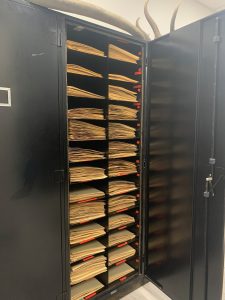Welcome to the College of Wooster Herbarium! This is the homepage for the College of Wooster Herbarium, a division of the Ruth W. Williams Hall Greenhouse.
Learn more about the herbarium on campus!
What is an herbarium?
An herbarium is a collection of dried plant specimens and any relevant data that is collected alongside the samples. Herbaria provide large amounts of information about plants, including data on taxonomy, ecology, anatomy, conservation biology, biodiversity, and ethnobotany. Additionally, herbaria are used for public outreach and education. The College of Wooster Herbarium is currently being used for education in classes involving plant anatomy and identification.
Herbaria are typically constructed by taking a plant specimen, placing it between two sheets of paper, and putting it under pressure which gradually flattens and dries the plant so it will stay in nearly its original state indefinitely. Over time the plants lose some of their original luster, becoming more faded and brittle, but the defining structures of the plant remain. Often, the specimen collector will orient the plant in the press such that the most notable characteristic of that particular species is highlighted, making it easier to identify. The identity of the plant is recorded on the paper and the plants are grouped together with other members of their genus, so that a botanist from one institute will feel at home in any herbarium in which they may find themselves.
Herbarium as a Research Tool
Herbariums are an incredibly useful tool for research. By examining herbarium specimens collected over many decades, researchers can observe changes in flowering times and other physiological features, as well as any shifts in native range. This is vital in studying the effects of the changing climate in response to global warming. As the climate warms, seasonal and regional weather is changing rapidly. This can have an enormous effect on plant growth patterns and distribution. The study of plant ecology is important in the analysis of ecosystem functions and biodiversity, all of which can have effects on wildlife, human industry, and society.
In response to the changing climate, researchers are using herbariums to evaluate and compare historical plant populations and ecology. Because herbarium specimens have dates and location data, scientists can compare their distribution, as well as their morphology at different times of year. In general, herbarium studies have found that flowering times have shifted earlier in the year, and population range has shifted towards cooler areas.
Herbarium History
Before herbariums, the Greeks were known to closely study plants and establish botanical gardens for the study and appreciation of plants. The first known herbarium was compiled by Luca Ghini in 1543, likely to pass on botanical knowledge to successive generations. However, it wasn’t until about 200 years later that herbariums were widely used. Plants have been central subjects of human study because of their bountiful nutritional and medicinal properties, so it may come as a surprise that there are no herbarium records before the sixteenth century. This is likely because good quality paper was hard to come by and expensive. This was a significant drawback, as the paper needed to support herbarium specimens must be substantial to properly hold and preserve the plants.
A prominent figure in herbarium history was Carl Linnaeus, whom you may recognize from high school biology class as the father of modern taxonomy. When he wasn’t busy naming new species of flora and fauna, he devised a better way for storing and accessing herbarium samples. Before Linnaeus, many specimens were glued to a single piece of paper, creating its own two dimensional garden. These pages were bound into books, forcing the puruser to flip through in order to find their desired specimen. Linnaeus invented a new method, advising herbarium creators to mount the specimens individually onto separate sheets of paper and leaving them unbound, leaving them readily accessible. He also built a cabinet-like structure to hold them in, making it like a filing cabinet for plants. This mode of storage is similar to the one you’ll find here at the college.

Today, herbariums are used as a resource for reference and research. Even though this method is tried and true, the age of information has begun to encroach on this ancient practice— many institutions have begun to digitize their herbarium archives (linked below). Places like Harvard, the University of Michigan, and even Ohio State University have embarked on this process of transferring herbarium information to an online platform, making it easy for anyone to browse their databases. With a quick search, anyone can find plentiful information on countless plant species, even finding lists of genera and species and images of associated herbarium specimens.
Harvard Herbarium: https://kiki.huh.harvard.edu/databases/specimen_index.html
University of Michigan: https://lsa.umich.edu/herbarium/databases.html
Ohio State: https://herbarium.osu.edu/online-data-access
MW made this webpage to increase plant appreciation as part of Wooster’s Field Botany course in Spring 2020.
References
Cowan, Richard S. “The Herbarium As a Data-Bank.” Arnoldia, vol. 33, no. 1, 1973, pp. 3–12.
Fosberg, F. R. “The Herbarium.” The Scientific Monthly, vol. 63, no. 6, 1946, pp. 429–434
“History.” The Holden Arboretum, 2 July 2019, www.holdenarb.org/about/history/.
Müller-Wille, Staffan. “Linnaeus’ Herbarium Cabinet: a Piece of Furniture and Its Function.” Endeavour, vol. 30, no. 2, June 2006, pp. 60–64., doi:10.1016/j.endeavour.2006.03.001.
“The Origin of Herbaria.” Bulletin of the Torrey Botanical Club, vol. 12, no. 12, 1885, pp. 129–131.